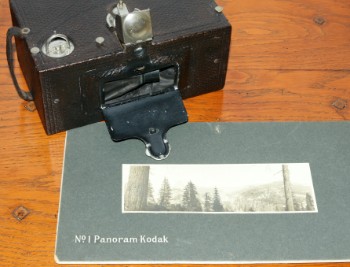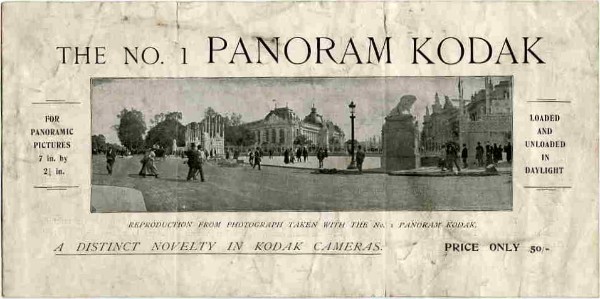 | 
| 
 
No. 1 Panoram Kodak (1900 - 1926)The No. 1 Panoram is a special purpose camera, taking panoramic pictures of 2 1/4 x 7 inch (5,7 x 18 cm) with a horizontal view of 112 degrees. There are several techniques to take panoramic pictures. One of them uses a rotating lens that projects the image on a curved film. The Panoram Kodak is build according to this principle. Driven by a spring the lens rotates around its vertical axis. At the back of the lens a flat cone is attached, through which a narrow strip of light is projected on the film. As the lens rotates, the back of the cone moves along the curved film. See the Elements in motion page for a demonstration. The spring is tensioned with a small lever on top of the camera, just visible behind the open hood of the little reflex finder. There is no separate shutter to open and close the lens. 
Very early model of the No. 1 Panoram and a sample panoramic photograph
| What's so special about the No. 1 Panoram, except its technical construction?
I think it was a very early, or maybe the earliest, simple and inexpensive panoramic camera for the amateur market. It cost $ 10, half of the contemporary $ 20 No. 4 Panoram Kodak and less than half of the competing original $ 25 to $ 30 No. 4 Al-Vista that was made by the Multiscope & Film Company. The No. 1 Panoram was introduced in 1900, and it took the Multiscope & Film Company six years before they put the similar but much cheaper $ 3.50 Baby Al-Vista No. 1 on the market. Until that time more than 15.000 No. 1 Panoram Kodaks had been sold. The No. 1 Panoram was a popular instrument, selling in large numbers (more than 22.000) until is was discontinued in 1926. It still can be used to take panoramic pictures on 120 size rollfilm. You only have to figure out the numbering in the red window, as the numbering on modern rollfilm is not designed for a 100 year old panoramic camera. | 
Advertising leaflet showing a sample picture |
 |
| |  |
|

